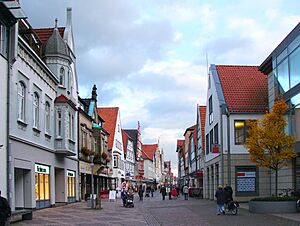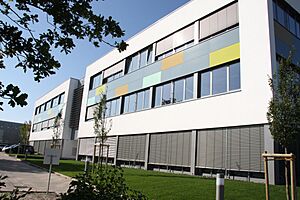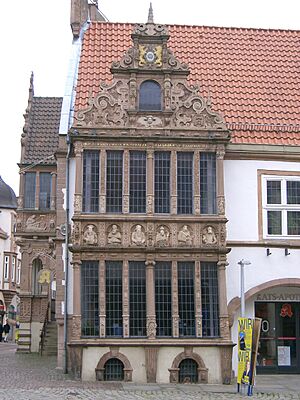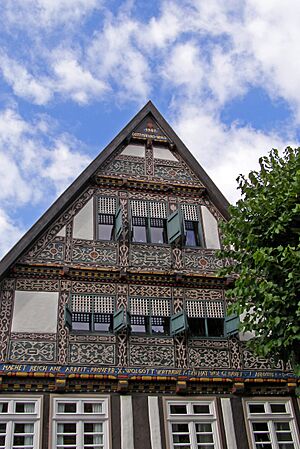Lemgo facts for kids
Quick facts for kids
Lemgo
|
||
|---|---|---|
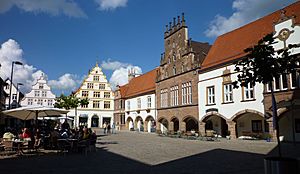
Market Square of Lemgo
|
||
|
||
| Country | Germany | |
| State | North Rhine-Westphalia | |
| Admin. region | Detmold | |
| District | Lippe | |
| Elevation | 100 m (300 ft) | |
| Population
(2022-12-31)
|
||
| • Total | 40,594 | |
| Time zone | CET/CEST (UTC+1/+2) | |
| Postal codes |
32657
|
|
| Dialling codes | 05261, 05266 (Brüntorf, partially Matorf-Kirchheide) | |
| Vehicle registration | LIP | |
| Website | www.lemgo.de | |
Lemgo (German pronunciation: [ˈlɛmɡoː]) is a historic town in the Lippe district of North Rhine-Westphalia, Germany. It is also a university town.
Lemgo is located between the Teutoburg Forest and the Weser Uplands. It is about 25 kilometers (15 miles) east of Bielefeld and 70 kilometers (43 miles) west of Hannover.
This town is the oldest in the former principality of Lippe. About 45,000 people live there. Lemgo is part of the OWL region. This area is very important for making machines and industrial electronics in Germany. In 2017, Lemgo was named one of the ten most beautiful half-timbered towns in Germany.
Contents
History of Lemgo
Lemgo was founded in 1190 by Bernard II, Lord of Lippe. It was built where two important trade routes crossed. This makes it the oldest town in the Lippe district.
Lemgo was once a member of the Hanseatic League. This was a powerful group of trading cities in northern Europe during the Middle Ages. Cities like those in the Netherlands, Germany, and Poland were part of it.
During the Protestant Reformation, Lemgo chose to follow Lutheranism in 1522. However, the rest of the Lippe area had trouble adopting this new faith until 1533.
In 1605, Simon VI, Count of Lippe, decided to follow Calvinism. He wanted everyone in Lemgo to change their religion too. This led to a disagreement called the Revolt of Lemgo. The town did not want to change its faith. This problem was solved in 1617 by the Peace of Röhrentrup. This agreement allowed Lemgo to decide its own religion.
During the Thirty Years' War, on October 15, 1638, Lemgo was surrounded by Palatine and Swedish troops. But the siege was quickly lifted when another army approached. Two days later, the Battle of Vlotho happened nearby.
British Army in Lemgo
From 1947 to 1993, soldiers from the British Army lived in Lemgo. The last group was the Royal Irish Regiment.
The soldiers stayed at Stornoway Barracks, which locals called Spiegelberg Kaserne. Before the army, this place was a camp for people who had lost their homes. Even earlier, it was used by a German army artillery unit.
After World War II, a Canadian army headquarters was at Spiegelberg Kaserne. Later, the British Army took over the site.
Research and Education
Lemgo is home to the TH OWL. It also has the Fraunhofer Institute IOSB-INA. These places work with businesses at the Centrum Industrial IT (CIIT). The CIIT is a special center for smart automation technologies.
Together, they form a hub for "Intelligent Systems Technologies" in the OWL region. This includes the Industry 4.0 Living Lab SmartFactoryOWL.
The Innovation Campus Lemgo is a place for the digital economy. It connects education, research, and business. This campus is one of three main centers in the "Intelligent Technical Systems Ostwestfalen-Lippe" (it's OWL) technology group. More than 8,500 people are on the campus on weekdays. This includes about 3,600 students and 4,100 school pupils.
Digital Transformation
In early 2018, the Fraunhofer Institute in Lemgo and its partners started the IoT Living Lab LemGO Digital. This project helps small and medium-sized towns become more digital. It shows how technology can improve city life.
Transport
The closest international airports are:
- Paderborn Lippstadt Airport, 50 kilometers (31 miles) south.
- Hannover Airport, 70 kilometers (43 miles) northeast.
- Münster/Osnabrück Airport, 85 kilometers (53 miles) west.
- Dortmund Airport, 105 kilometers (65 miles) southwest.
A train called the RB 73 "The Lipperländer" runs every hour to Bielefeld main station. The Innovation Campus Lemgo even has its own train station, Lemgo-Lüttfeld railway station. The nearest major highway is the Bundesautobahn 2 (A2). It is only 9 kilometers (5.6 miles) west of Lemgo.
Culture
Lemgo's old town was not damaged during World War II. Because of this, its historic look, with buildings from the Renaissance period, is still preserved.
Museums in Lemgo
Lemgo has several interesting museums:
- The Museum Hexenbürgermeisterhaus used to show copies of old torture tools.
- The Museum Junkerhaus shows the art and life of artist Karl Junker. His house from 1891 is covered with beautiful carvings.
- The Städtische Galerie Haus Eichenmüller has changing art shows by modern artists.
- The oil mill is a working watermill with a museum next to it.
- The Weser Renaissance Museum Schloss Brake shows art and culture from the Weser Renaissance time.
- The Frenkelhaus shows a permanent exhibit about the history of Jewish people in Lemgo.
Historical Buildings
Hexenbürgermeisterhaus
The most famous house in Lemgo is the Hexenbürgermeisterhaus, built in 1571. It has a special style called Weser Renaissance. Its unusual name comes from a mayor named Cothmann from the 17th century. He used accusations of witchcraft to get rid of his political rivals. He caused many people to be killed.
The house's front has a wide, detailed area with carvings. On the right side, there is a bay window. The upper part of the front is decorated with half-columns and ledges.
Town Hall
Lemgo's Town Hall is also built in the Weser Renaissance style. It is so important that it is on the UNESCO list of famous European works. The Town Hall was built in different stages over time. As the town grew, more space was needed for city work. Instead of building a new hall, they bought nearby houses and added them to the Town Hall.
The oldest part is a long hall from the 13th century. The middle part is in the Gothic style, built around 1480-1490. It holds the Council Chamber. Old town halls often had open ground floors for public court hearings.
Newer parts from the 15th and 16th centuries are in the Weser Renaissance style. The "Apothecary's Corner" is a beautiful example of this style. The "council foliage" and the "Kornherrenstube" upstairs are similar. The "Neue Ratsstube" is simpler but balances the building's front facing the market.
Brake Castle
Brake Castle is a very important old building. Its history goes from the 12th to the 19th century. The castle you see today is the result of many changes and additions. Around 1190, Lord Bernhard II of Lippe built a stone castle. It was about the same size as the castle now. In 1306, it was first mentioned as "castrum brac." It was the favorite home of the noble lords (and later counts) of Lippe.
In 1587, it was made bigger as a home for the Counts of Lippe, in the Renaissance style. A moat surrounds the castle. It stands on the foundations of one of the largest medieval castles in Northern Germany. The tall tower makes it a clear landmark for the old Hanseatic town of Lemgo. The buildings near the castle still show what an early modern noble home looked like. This includes the estate, three old mills, and a wash house.
Other Historical Town Houses
Many old merchant houses from the late Gothic and Renaissance periods still stand in the historic city center. You can find half-timbered and stone houses with fancy gables. Examples include the "Neustädter Twins" and the former Adlerhof.
Studies show that parts of the houses at Mittelstraße 54 and 56 are even older, from the 13th century. This is rare for such old buildings. Mittelstraße is a shopping street where you can find the city's most important town houses. There are also hundreds of smaller half-timbered houses from the 15th to the 19th century, especially in the old town.
Sport
TBV Lemgo is one of Germany's best handball clubs. They have won many titles, including the league, Cup, and Supercup. They also won the European Cup Winner's Cup in 1996 and the European Cup in 2006.
Twin Towns – Sister Cities
Lemgo is connected with these sister cities:
Hörstmar County Primary School in Lemgo has been twinned with a school in Holme on Spalding Moor since 1989.
Notable People
Many famous people have connections to Lemgo:
- Simon VII, Count of Lippe (1587–1625), a Count of Lippe.
- Johann Cothmann (1588–1661), a diplomat and lawyer.
- Philip I, Count of Schaumburg-Lippe (1601–1681), a Count.
- Simon Peter Tilemann (1601–1668), a painter.
- Engelbert Kaempfer (1651–1716), a scientist, doctor, and explorer.
- Christian Wilhelm von Dohm (1751–1820), a historian and writer.
- Wilhelm Engelmann (1808–1878), a publisher and bookseller.
- Heinrich Schacht (1840–1912), a teacher and bird expert.
- Fred (1876–1932) and August Duesenberg (1879–1955), who built Duesenberg cars. They were born in the Kirchheide area.
- Heinrich Drake (1881–1970), a politician.
- Anatol Ugorski (1942-2023), a Russian-born German classical pianist.
- Axel Haverich (born 1953), a surgeon.
- Pinar Atalay (born 1978), a journalist.
- Dominic Klemme (born 1986), a road bicycle racer.
- Matthias Blübaum (born 1997), a chess grandmaster.
See also
 In Spanish: Lemgo para niños
In Spanish: Lemgo para niños




